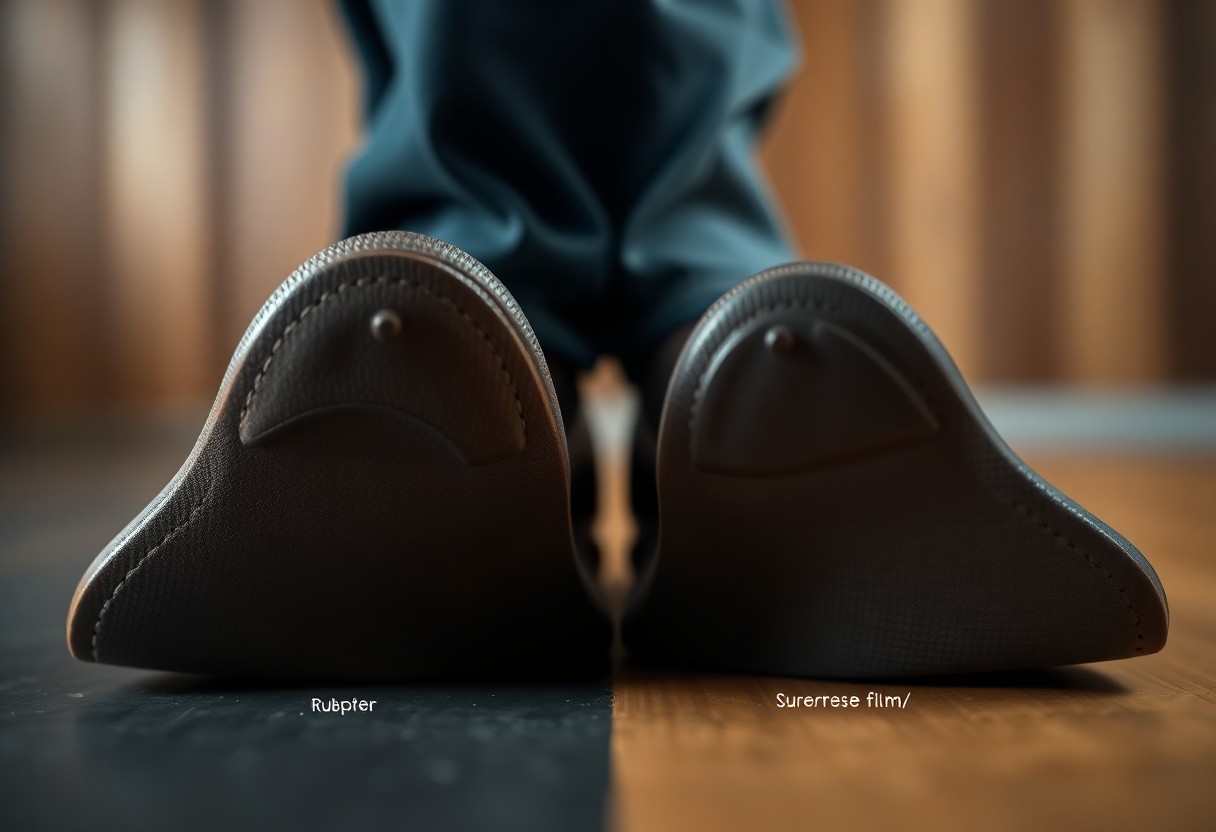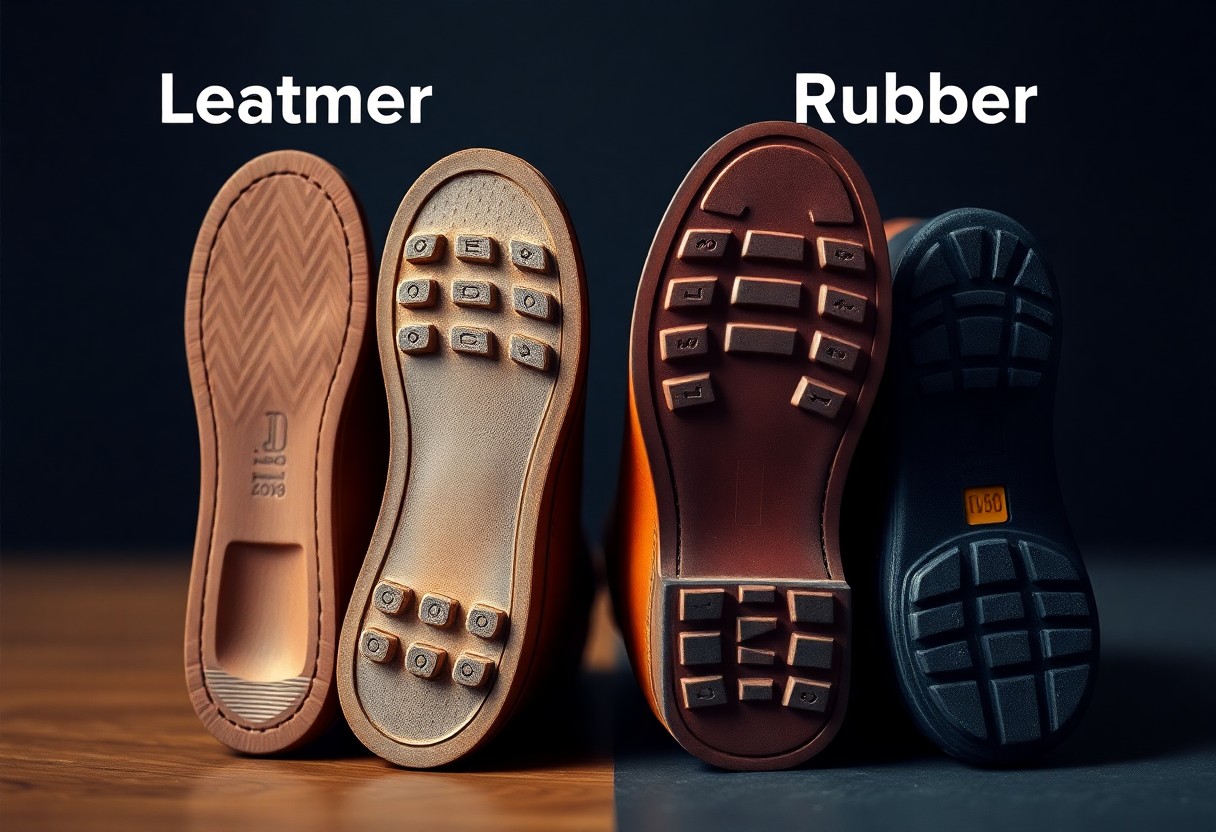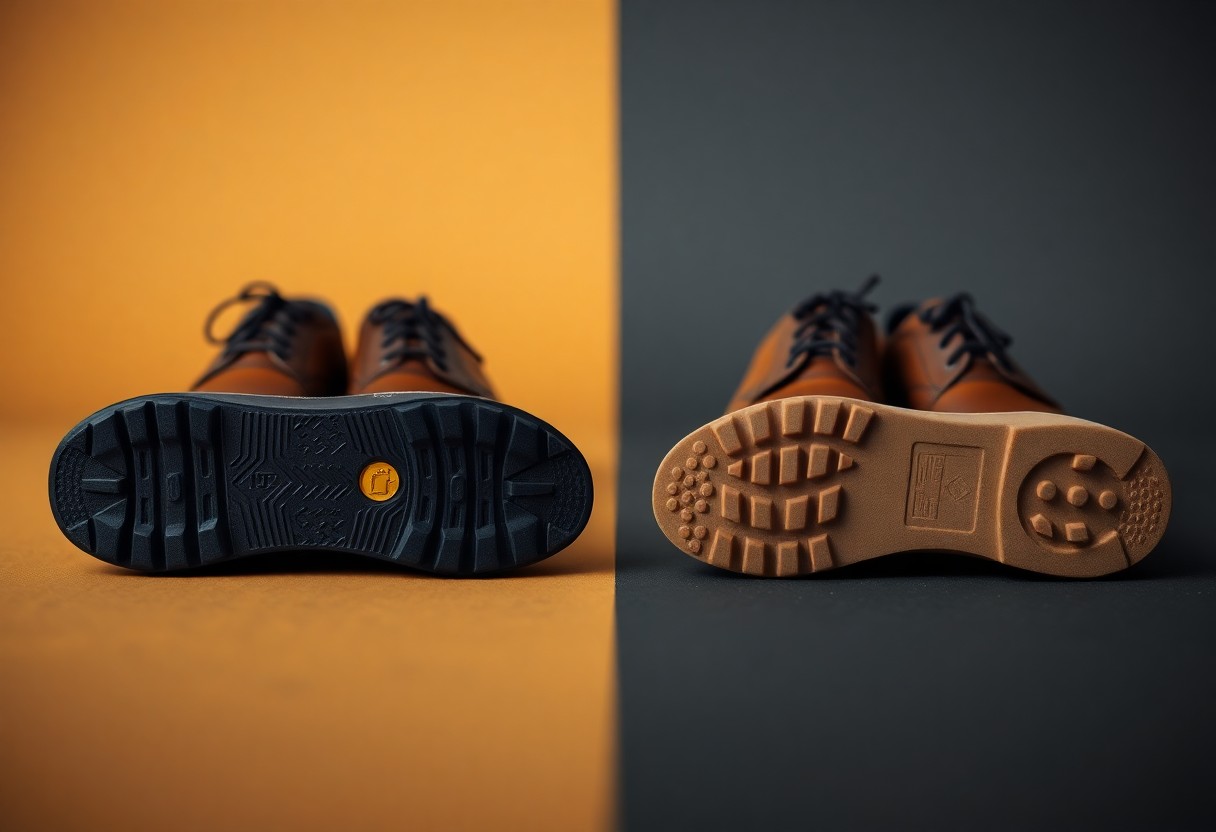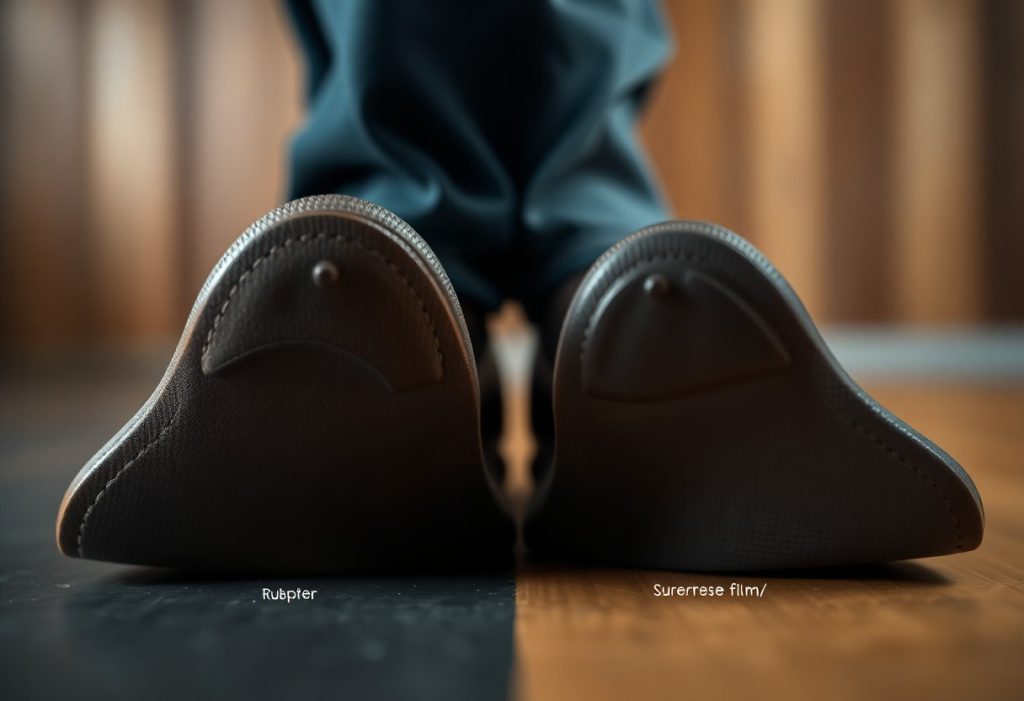When selecting new footwear, buyers often face the decision between leather and rubber soles. This critical choice regarding sole material can significantly impact your comfort and overall walking experience. While leather soles offer outstanding breathability and a unique fit that molds to the contours of your feet, rubber soles are celebrated for their excellent grip and water resistance. Leather soles are particularly suited for formal occasions and develop a distinctive character over time, while rubber soles provide immediate comfort and optimal traction, especially in wet conditions. This comprehensive guide will equip you with the insights needed to explore the key differences between these materials, helping you make the best choice tailored to your individual needs.

Explore the Distinct Features of Sole Materials for Better Footwear Choices
By gaining a deep understanding of the various sole materials available, you can make informed footwear decisions that enhance your everyday comfort. Each material comes with its own set of unique advantages and disadvantages, which can significantly affect your daily comfort, shoe longevity, and overall satisfaction. The choice between leather and rubber soles will not only influence your walking experience but also play a crucial role in your foot health and the maintenance requirements of your footwear.
Discover the Advantages of Choosing Leather Soles
For centuries, leather has remained the traditional choice for premium footwear. Shoes featuring leather soles are crafted from natural materials that gradually conform to the shape of your feet, providing a tailored fit that enhances comfort as you wear them. This material promotes optimal airflow, allowing your feet to breathe while adjusting to temperature changes. With proper care, leather soles can last between 3 to 5 years with regular use, making them a worthwhile investment for those seeking durability and style.
Understanding the Key Benefits of Rubber Soles
Rubber soles are recognized for their exceptional water resistance and immediate flexibility. Footwear with rubber soles provides superior grip on slick surfaces and offers impressive shock absorption, ensuring comfort right from the first wear. This material maintains its shape and performance across a variety of weather conditions, making rubber soles an ideal option for daily wear and active lifestyles.
Rubber soles guarantee consistent performance even in challenging environments. High-quality rubber soles typically last between 2 to 3 years and require minimal maintenance. While rubber excels in providing reliable traction and stability in wet or slippery situations, it generally offers less breathability compared to leather options.
Examine Comfort Considerations for Different Sole Materials
Understanding how different sole materials influence your daily walking experience is crucial for selecting the right footwear. The decision between leather and rubber soles can have a profound impact on your foot health and overall comfort. The ideal sole material should align with your walking habits, foot structure, and daily activities to ensure the best possible fit and support.
Comfort Features of Leather Soles Explained
The comfort offered by leather soles stems from their unique ability to naturally mold to the shape of your feet and their inherent breathability. This adaptability provides several benefits, including:
- Custom contouring that adjusts to your foot shape
- Natural air circulation that keeps your feet dry and comfortable
- Cork layer cushioning that significantly enhances comfort
- Progressive softening as you continue to wear them
By recognizing these features, you can make a well-informed decision that prioritizes long-term comfort and foot health, ensuring your footwear supports your lifestyle.
Immediate Comfort Characteristics of Rubber Soles
Rubber soles excel in various weather conditions, providing instant comfort and shock-absorbing qualities. You will experience immediate flexibility with little to no break-in time, making rubber soles particularly suitable for quick, on-the-go use.
The advanced technology behind rubber soles ensures superior grip and water resistance. While rubber does not conform to your feet as leather does, it consistently delivers excellent shock absorption and retains its shape, offering protection from hard impacts. This adaptability makes rubber soles ideal for extensive urban walking, enhancing your comfort in bustling environments.
Assessing Durability of Different Sole Materials
When deciding between leather and rubber soles, it’s essential to consider their varying wear patterns and overall durability. Your walking habits and local weather conditions can significantly affect the lifespan of your soles. Both materials offer unique advantages regarding durability, but their effectiveness can vary widely based on usage and maintenance practices over time.
Insights on the Durability of Leather Soles
With proper care and maintenance, leather soles can provide exceptional longevity. When shielded from excessive moisture and equipped with protective toe taps, your leather-soled shoes can last anywhere from 3 to 5 years with regular use. The quality of the leather can be enhanced with multiple layers; for instance, a triple leather sole can outperform many other options. However, it’s critical to keep them dry and properly maintained to ensure their durability.
Durability Characteristics of Rubber Soles
Rubber soles are renowned for their superior resistance to water and daily wear. Your rubber-soled shoes can endure demanding conditions and typically last between 2 to 4 years with regular use. These soles excel on wet surfaces and require far less maintenance compared to leather alternatives.
However, it’s important to recognize that the durability of rubber soles is contingent on the quality and thickness of the rubber compound used. High-quality rubber compounds can last up to 8 years with proper care, while inferior versions may wear out within a few months. Your individual walking style and frequency of use will ultimately determine the actual lifespan of rubber soles.
Performance Assessment in Various Weather Conditions
To make an informed choice about your footwear, understanding how different soles perform under various weather conditions is essential. Your decision between leather and rubber soles can significantly affect your comfort and safety in diverse weather situations. Each material presents unique advantages and limitations that influence their performance in both wet and dry conditions.
Performance of Leather Soles in Different Weather Conditions
Contrary to common belief, leather soles may not be the optimal choice for wet conditions. Water can damage leather soles, making them slippery. Leather performs best in dry weather, where it provides excellent breathability. In wet conditions, these soles can absorb up to 80% of their weight in water, leading to accelerated wear and potential damage to your shoes.
Rubber Soles and Their Performance in Varied Elements
When comparing the two options, rubber soles provide superior grip and water resistance. You can confidently wear rubber-soled shoes in rain, snow, and on slippery surfaces, benefiting from enhanced traction. These soles maintain their properties in temperatures ranging from -10°C to 40°C, making them more versatile for year-round use.
A significant advantage of rubber soles is their exceptional water resistance and resilience in harsh conditions. They preserve their shape and grip even after prolonged exposure to moisture. Their non-slip characteristics substantially enhance safety on wet surfaces, reducing your risk of accidents by up to 50% compared to leather soles.

Choosing the Right Style for Your Footwear
When it comes to style, the choice of sole material can greatly influence the overall appearance of your shoes and their appropriateness for various occasions. While leather soles radiate a refined and sophisticated aesthetic, rubber soles offer greater versatility for everyday wear. Your selection should reflect your lifestyle and the intended use of your footwear.
Classic Appeal of Leather Soles for Formal Wear
For formal events, leather soles remain the preferred choice. You will find them prominently featured in high-end dress shoes and formal footwear. The sleek design and natural patina that develops over time enhance their visual allure. Your leather-soled shoes will present a polished edge and maintain an elegant silhouette that epitomizes classic footwear design.
Modern Functionality of Rubber Soles for Everyday Use
Currently, around 70% of contemporary shoes feature rubber soles. Your daily activities often require footwear that can handle various surfaces and weather conditions. Rubber soles provide improved grip and weather resistance, making them ideally suited for business casual settings and everyday wear.
Additionally, it’s noteworthy that modern hybrid options combine both materials, providing the best of both worlds. These innovative combinations offer the elegance of leather along with the practicality of rubber. You can find dress shoes that include thin rubber inserts or entire rubber soles designed to mimic leather, providing a balanced solution for your footwear collection.

Cost Assessment of Sole Materials for Footwear
Despite the initial cost differences, your choice between leather and rubber soles impacts both short-term expenses and long-term value. While leather soles may require more maintenance and occasional resoling, they can last 15 to 20 years with proper care. Rubber soles might provide better initial value, but they often necessitate complete replacement once worn out.
Understanding the Initial Cost of Sole Types
Typically, leather-soled shoes are priced 20 to 30% higher than their rubber-soled counterparts. Investing in leather soles reflects the quality of materials and the skilled craftsmanship involved in their production. This higher upfront cost often signifies superior construction methods, such as Goodyear welting, which ensures durability and longevity.
Evaluating Long-term Value of Sole Materials
At first glance, rubber soles may seem more cost-effective, but leather-soled shoes can offer better value over time. With proper maintenance and resoling, leather-soled shoes can last for decades, whereas rubber soles typically require complete replacement after becoming worn.
Although leather soles require regular maintenance and resoling every 2 to 3 years, the costs of these services are generally lower than purchasing new shoes. Your investment in leather soles pays dividends through their ability to be repaired and restored, a feature that most rubber soles lack once they become damaged.
Choosing the Best Option for Your Footwear Needs
Your choice between leather and rubber soles ultimately depends on your personal preferences and lifestyle requirements. Leather soles offer superior moldability and elegance, making them ideal for those who seek shoes that adapt to their feet while presenting a classic appearance. Conversely, rubber soles provide immediate comfort and excellent water resistance, making them ideal for individuals who frequently walk in wet conditions. Your walking habits, local climate, and comfort preferences will all play a vital role in guiding your choice. Both types of soles serve an important function in a well-rounded footwear collection, allowing you to select based on the primary use for each pair.
Your Questions Answered: Frequently Asked Questions
Q: What are the comfort differences between leather and rubber soles?
A: Leather soles gradually conform to your feet, creating a personalized fit that enhances comfort over time, especially when complemented by cork filling and adequate arch support. In contrast, rubber soles offer immediate flexibility and superior shock absorption but do not mold to your foot shape. While leather provides better all-day comfort after breaking in, rubber tends to feel comfortable initially but may contribute to foot fatigue during prolonged wear.
Q: How do leather and rubber soles compare in terms of durability and weather resistance?
A: Double or triple leather soles with toe taps can last for many years with the right care. However, single-layer leather soles wear out more quickly and are susceptible to water absorption. Rubber soles excel in water resistance and perform well on rough surfaces. They require less maintenance and are more effective in wet conditions. Ultimately, your choice should consider your walking environment and how often you wear the shoes.
Q: Which type of sole should I choose based on my specific needs?
A: Opt for leather soles for formal shoes and office wear, particularly if your activities are mainly indoors. They offer enhanced breathability and a sophisticated look. Alternatively, select rubber soles for daily commutes, frequent outdoor walking, or rainy conditions. Consider your walking surfaces—leather performs well on carpets and smooth floors, while rubber excels on rough pavements and wet surfaces.
The Article Leather soles vs rubber soles key differences benefits and how to choose the right one appeared first on My Shoes Finder
The Article Leather Soles vs Rubber Soles: Key Differences and Benefits Was Found On https://limitsofstrategy.com



Your exploration of the differences between leather and rubber soles highlights a decision that many consumers often overlook but is crucial for both comfort and functionality. When I first began investing in quality footwear, I found myself drawn to leather soles for their elegance and the way they mold to the foot. I remember wearing a pair to a formal event and feeling a noticeable difference in how they complemented my outfit—there’s something timeless about leather that immediately elevates one’s appearance.
It’s great to hear about your experience with leather soles. They really do add that touch of refinement, don’t they? The way they mold to your foot over time can transform not just the fit, but the entire way you feel while wearing them. There’s a unique connection to craftsmanship in a quality pair of leather shoes that seems to tell a story with each wear.